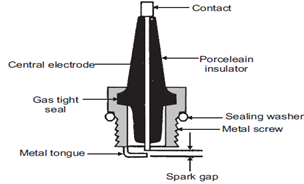←
Automobile Engineering
Spark Plugs
Introduction:
Spark plugs transmit electrical energy that turns fuel into working energy. A sufficient amount of voltage must be supplied by the ignition system to cause it to spark across the spark plug's gap. This is called "Electrical Performance."
Properties of the spark plug:
The spark plug has two primary functions:
- To ignite the air/fuel mixture
- To remove heat from the combustion chamber
The temperature of the spark plug's firing end must be kept low enough to prevent pre-ignition, but high enough to prevent fouling. This is called "Thermal Performance", and is determined by the heat range selected.
- Spark plugs do not create heat, they can only remove heat. The spark plug works as a heat exchanger by pulling unwanted thermal energy away from the combustion chamber, and transferring the heat to the engine's cylinder head. The heat range is defined as a plug's ability to dissipate heat.
- The rate of heat transfer is determined by; the insulator nose length, gas volume around the insulator nose, the materials/construction of the center electrode and porcelain insulator.
- A spark plug's heat range has no relationship to the actual voltage transferred though the spark plug. Rather, the heat range is a measure of the spark plug's ability to remove heat from the combustion chamber.
- The heat range measurement is determined by several factors; the length of the ceramic center insulator nose and its' ability to absorb and transfer combustion heat, the material composition of the insulator and center electrode material.
Working of the spark plug:
Figure shows atypical spark plug used with petrol engines.
- It mainly consists of a central electrode and metal tongue.
- Central electrode is covered by means of porcelain insulating material.
- Through the metal screw the spark plug is fitted in the cylinder head plug.
- When the high tension voltage of the order of 30000 volts is applied across the spark electrodes, current jumps from one electrode to another producing a spark.
